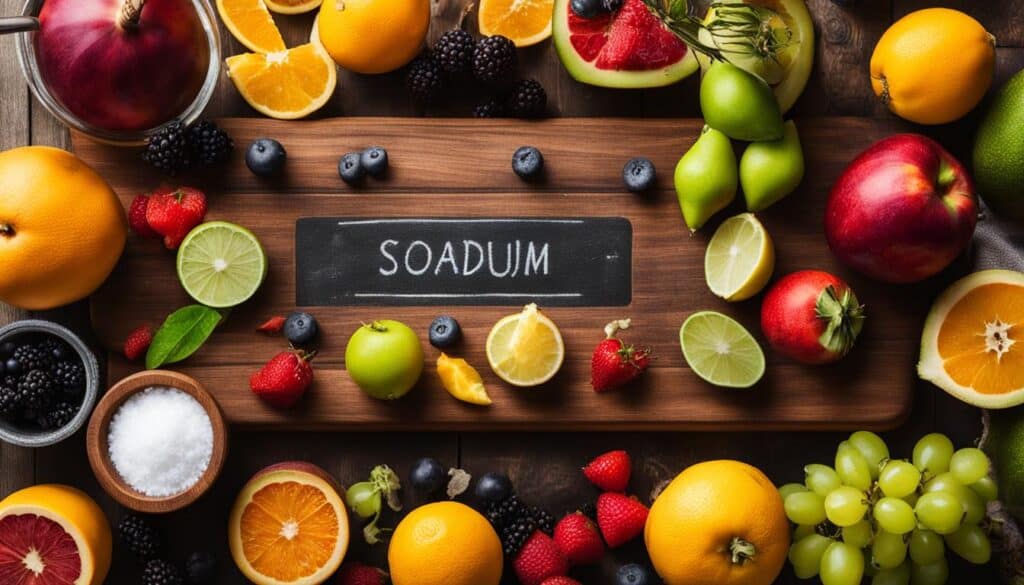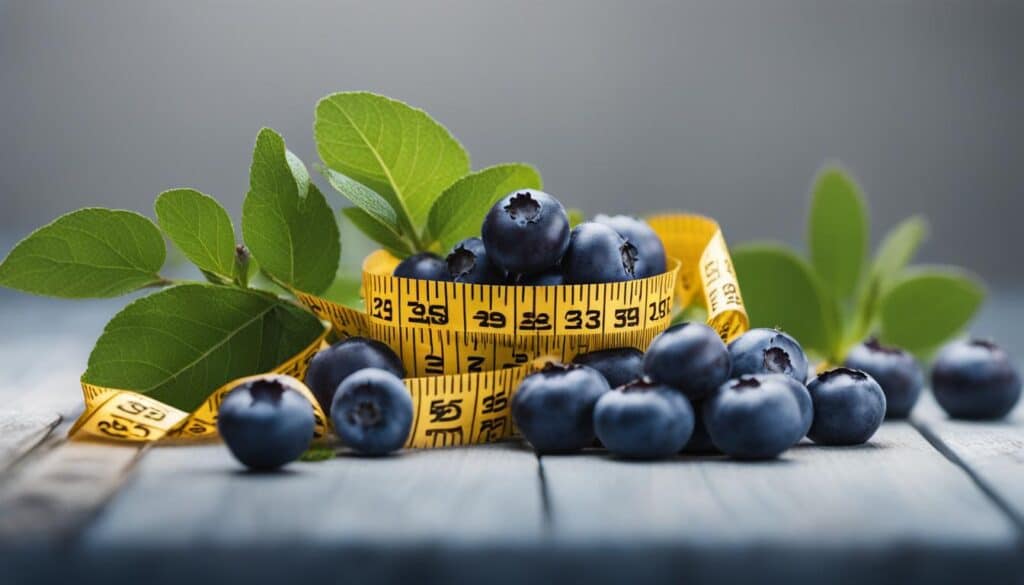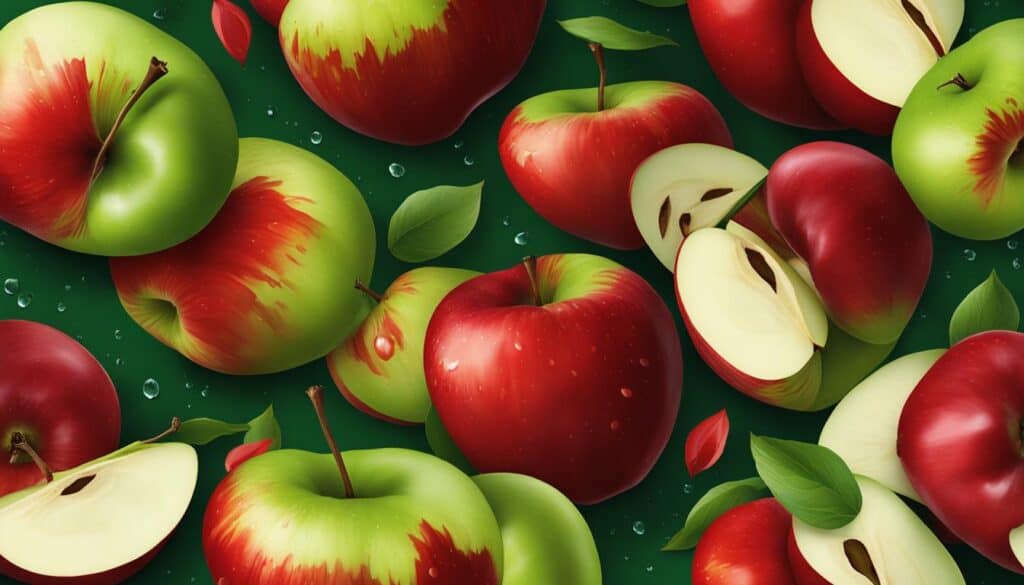When it comes to our diets, there are many things we consider, including our intake of essential nutrients. One question that often comes up is whether or not fruit contains sodium. So, let’s dive into the topic and uncover the truth!
According to nutritionist Jeff Novick, if 100% of your diet consists of fresh fruits and vegetables, your intake of naturally occurring sodium would be 500 milligrams. While sodium is naturally present in most foods, it’s impossible to get too little of it unless you have a health issue. However, the average sodium intake in North America is 3000-5000 mg per day. So, let’s explore the role of sodium in fruits and the bigger picture of sodium in our diets.
Key Takeaways:
- Fresh fruits and vegetables contain naturally occurring sodium, but it is not a major concern for most people’s sodium intake.
- The average sodium intake in North America is much higher than the natural sodium found in fruits.
- Sodium in fruits is minimal compared to the sodium content in processed foods and restaurant meals.
- It’s important to focus on reducing sodium from processed foods rather than being overly concerned about the sodium in fruits.
- Choosing fresh, unprocessed fruits and vegetables is a great way to enjoy a nutritious diet with healthy sodium levels.
The Unconscious Addict: How Sodium Sneaks into Your Diet
When it comes to our sodium intake, it’s not just about the salt shaker on our kitchen table. Surprisingly, a significant amount of sodium in our diet comes from hidden sources that we may not even be aware of. While fresh fruits are often praised for their health benefits and low sodium content, it’s important to understand how sodium can sneak into our diet through processed foods and restaurant meals.
Processed foods and restaurant meals make up the majority of our sodium intake, accounting for about 80% of the total. These foods often contain high amounts of sodium to enhance flavor, improve preservation, and extend shelf life. Even seemingly healthy options like vegetable juice and deli meats can be loaded with sodium. That’s why it’s crucial to be mindful of hidden sources of sodium and make conscious choices to reduce our intake.
But here’s the good news: fresh fruits can be a sodium-free option for those looking to limit their sodium intake. Fruits naturally have low sodium content and can be a delicious and nutritious addition to a well-balanced diet. By incorporating a variety of fruits into our meals and snacks, we can enjoy their natural sweetness and reap the many health benefits they offer.
In summary, while sodium can sneak into our diet through hidden sources like processed foods, fresh fruits remain a sodium-free option. By being aware of hidden sodium and making conscious choices, we can reduce our sodium intake and prioritize a healthy lifestyle.
The Salt Shaker Isn’t To Blame: Be Mindful of Processed Foods
When it comes to sodium intake, many people falsely believe that the salt shaker is the main culprit. However, the truth is that only about 10% of the sodium in our diet comes from the salt shaker itself. The majority, around 80%, actually comes from processed foods and restaurant meals. This is an important distinction to make, as it highlights the need to focus on reducing sodium from processed foods rather than being overly concerned about the naturally occurring sodium in fruits.
While it is true that some fruits may naturally have higher sodium levels than others, the amount they provide is relatively small compared to the overall sodium content in processed foods. It’s essential to keep this in mind and avoid demonizing fruits as a significant source of sodium in our diets. Instead, we should prioritize making conscious choices to limit our intake of processed foods and opt for fresh, unprocessed options as much as possible.
The Role of Processed Foods in Sodium Intake
To truly understand the impact of sodium on our diets, it’s essential to recognize the prevalence of processed foods in our modern food culture. These foods are often loaded with sodium as a means of enhancing flavor and extending shelf life. From canned soups to frozen meals, many processed foods contain excessive amounts of sodium that can contribute to health issues such as high blood pressure and cardiovascular disease.
To illustrate the significant difference between sodium levels in fruits and processed foods, let’s take a look at a comparison table:
| Food Item | Sodium Content per Serving |
|---|---|
| Apple | 0 mg |
| Orange | 0 mg |
| Banana | 1 mg |
| Canned Soup | 800 mg |
| Frozen Pizza | 1000 mg |
As you can see from the table above, fruits like apples, oranges, and bananas have negligible amounts of sodium, with some even having zero sodium content. On the other hand, processed foods like canned soups and frozen pizzas contain significantly higher levels of sodium per serving. This stark contrast emphasizes the importance of reducing our reliance on processed foods and opting for fresh fruits as part of a healthy diet.
In conclusion, while it’s essential to be mindful of our sodium intake, the focus should be on reducing sodium from processed foods rather than being overly concerned about the naturally occurring sodium in fruits. By making conscious choices and prioritizing fresh, unprocessed options, we can enjoy a nutritious diet with healthy sodium levels while reaping the benefits of the vitamins, minerals, and antioxidants that fruits provide.
Never Trust The Front Label: Read the Nutrition Facts
When it comes to determining the sodium content of a product, it’s crucial to never trust the front label alone. Front labels can be misleading, and foods that seem healthy may actually be high in sodium. That’s why it’s important to always read the Nutrition Facts on the back of the packaging.
The Nutrition Facts provide detailed information about the sodium levels in the product. By reading the Nutrition Facts, you can make informed choices and opt for low-sodium options when available. Some foods that may seem healthy, such as organic products or vegetable juice, can still be high in sodium. By being diligent and reading the Nutrition Facts, you can ensure you are making choices that align with your sodium intake goals.
Table: Comparison of Sodium Content in Different Fruits
| Fruit | Sodium Content (per 100g) |
|---|---|
| Apple | 1mg |
| Orange | 0mg |
| Banana | 1mg |
| Watermelon | 1mg |
| Grapes | 2mg |
In addition to reading the Nutrition Facts, it’s important to keep in mind that fresh fruits generally have low sodium content. As shown in the table above, fruits like apples, oranges, bananas, watermelon, and grapes have minimal sodium content, making them suitable for those watching their sodium intake. Incorporating these fruits into your diet can provide a flavorful and healthy way to enjoy a variety of nutrients without worrying about excessive sodium.
“Reading the Nutrition Facts is essential for understanding the sodium content in products. It’s easy to be deceived by front labels, so always take the time to check the detailed information on the back. Opting for low-sodium fruits can play a significant role in maintaining a balanced diet.” – Nutritionist Jessamine Green
The 1:1 Calorie/Sodium Rule: A Simple Guideline
When it comes to managing your sodium intake, a helpful guideline to consider is the 1:1 calorie/sodium rule. This rule compares the number of calories in a food to its sodium content, giving you an indication of whether the sodium level is within a reasonable range. By following this rule, you can make more informed choices about the foods you consume.
For example, let’s say you’re looking at two different food products. Product A has 100 calories and 100 milligrams of sodium, while Product B has 100 calories and 200 milligrams of sodium. According to the 1:1 calorie/sodium rule, both products have a reasonable amount of sodium. However, if you come across a product that has 100 calories and 400 milligrams of sodium, it would exceed the recommended sodium content for that calorie level.
It’s important to note that the 1:1 calorie/sodium rule is just a guideline and should be used in conjunction with other factors, such as overall nutritional needs and dietary restrictions. It can be a useful tool to help you make more mindful choices when it comes to your sodium intake.
| Food Product | Calories | Sodium |
|---|---|---|
| Product A | 100 | 100mg |
| Product B | 100 | 200mg |
| Product C | 100 | 400mg |
“The 1:1 calorie/sodium rule is a simple guideline to help you determine if a product has a reasonable amount of sodium.” – Nutritionist
Sodium Isn’t The Only Problem: A Balanced Approach to Nutrition

When it comes to maintaining a healthy diet, it’s essential to take a balanced approach. While sodium is a concern for many, it’s important to remember that no single nutrient on its own is as important as the overall quality of your diet. Instead of fixating solely on sodium intake, it’s crucial to focus on consuming a variety of fresh, unprocessed, plant-based whole foods that provide your body with the necessary nutrients it needs, including sodium, in ideal ratios.
While fruits may naturally contain small amounts of sodium, they should not be a major concern when it comes to sodium intake. The real issue lies in the excessive sodium found in processed foods and restaurant meals. These sources account for the majority of sodium intake in the average North American diet. By reducing your consumption of processed foods and opting for whole, unprocessed foods, such as fruits, you can effectively manage your sodium intake.
So, how can you ensure a balanced approach to nutrition? Start by making fresh fruits a staple in your diet. Not only are they naturally low in sodium, but they also provide a wide range of essential vitamins, minerals, and antioxidants that support overall health and well-being. Whether you enjoy the refreshing sweetness of tangerines, the vibrant burst of flavor from strawberries, or the crisp bite of apples, incorporating a variety of fruits into your meals and snacks can add both nutritional value and deliciousness to your diet.
Remember, a balanced approach to nutrition is about more than just one nutrient. It’s about nourishing your body with a wide range of wholesome foods that provide all the necessary nutrients in optimal proportions. By prioritizing fresh, unprocessed fruits and vegetables in your diet, you can ensure a nutritious and well-rounded eating plan that supports your overall health and wellness.
| Fruit | Sodium Content (per 100g) |
|---|---|
| Grapefruit | 0mg |
| Blueberries | 1mg |
| Apples | 0mg |
| Tangerines | 2mg |
| Strawberries | 1mg |
Grapefruit: Nutritional Benefits and Low Sodium Content
Grapefruit is a nutritious fruit that naturally has a low sodium content. It can be a great addition to a healthy diet, providing essential vitamins and minerals. In addition, grapefruit has been shown to have potential health benefits, such as reducing the risk of insulin resistance and supporting heart health.
According to the United States Department of Agriculture (USDA), a medium-sized grapefruit contains only about 1 milligram of sodium. This low sodium content makes grapefruit a suitable choice for individuals who are watching their sodium intake.
Grapefruit is also a good source of vitamin C, which is important for immune function, collagen production, and antioxidant protection. It is also rich in fiber, which can support digestive health and help with weight management. Additionally, grapefruit is a hydrating fruit, as it contains a high water content, making it a refreshing choice for those looking to stay hydrated.
| Nutrient | Amount per 1 medium grapefruit (230g) |
|---|---|
| Calories | 96 |
| Protein | 2 grams |
| Fiber | 4 grams |
| Vitamin C | 64 milligrams |
| Potassium | 328 milligrams |
| Sodium | 1 milligram |
It’s important to note that grapefruit can interact with certain medications, such as statins and certain blood pressure medications. Therefore, if you are taking any medications, it’s always best to consult with a healthcare professional before making any changes to your diet.
The Benefits of Grapefruit:
- Low in sodium
- Rich in vitamin C
- Good source of fiber
- Hydrating
- Potential health benefits: reducing the risk of insulin resistance and supporting heart health
“Grapefruit is a refreshing and nutritious fruit that can be enjoyed as part of a well-balanced diet. Its low sodium content makes it a great option for individuals looking to reduce their sodium intake. Plus, it provides essential vitamins and minerals that support overall health and well-being.”
Blueberries: A Healthy Choice with Low Sodium

Blueberries are not only delicious but also offer numerous health benefits. These little berries are packed with antioxidants, vitamins, and minerals, making them a nutritious choice for any diet. One advantage of blueberries is their low sodium content, making them suitable for individuals watching their sodium intake. Incorporating blueberries into your meals and snacks is a simple and flavorful way to support your overall well-being.
Research suggests that blueberries may have cognitive and cardiovascular benefits. The antioxidants present in blueberries can help protect against oxidative stress, potentially improving memory and cognitive function. Additionally, the high levels of flavonoids found in blueberries have been linked to a lower risk of heart disease by reducing inflammation and improving blood pressure control.
When it comes to their sodium content, blueberries are an excellent choice for those aiming to maintain a low-sodium diet. With only trace amounts of sodium, blueberries offer a refreshing and healthy alternative to sodium-rich snacks and processed foods. Whether enjoyed fresh, frozen, or added to yogurts and smoothies, blueberries are a versatile option that can be easily incorporated into any meal plan.
Blueberry Nutritional Information (per 1 cup serving):
| Nutrient | Amount |
|---|---|
| Calories | 84 |
| Carbohydrates | 21 grams |
| Fiber | 3.6 grams |
| Vitamin C | 14.4 milligrams |
| Vitamin K | 28.6 micrograms |
| Potassium | 114 milligrams |
Source: National Nutrient Database for Standard Reference Legacy Release
Incorporating blueberries into your diet provides a wide range of health benefits due to their antioxidant-rich profile. Whether enjoyed on their own or added to various dishes, blueberries are a nutritious choice that can support your overall well-being while keeping your sodium intake in check.
Apples: Supporting Heart Health with Low Sodium Content

When it comes to choosing fruits with low sodium content, apples are a top contender. Not only are apples tasty and versatile, but they also offer numerous health benefits. Research suggests that regular apple consumption may help lower LDL cholesterol levels, which is beneficial for heart health.
Apples are also a good source of fiber and vitamin C, further contributing to their nutritional value. Incorporating apples into your daily diet can be a simple and delicious way to promote a healthy lifestyle.
In addition to their low sodium content, apples are a great snack option for those looking to watch their sodium intake. They provide a satisfying crunch and can be enjoyed on their own or paired with other healthy foods, such as nut butter or yogurt.
So, the next time you’re looking for a heart-healthy snack or ingredient, reach for an apple. Its low sodium content, combined with its nutritional benefits, make it a smart choice for supporting overall health and well-being.
Tangerines: Potential Health Benefits with Low Sodium Content

Tangerines are a delicious and nutritious citrus fruit that offer numerous health benefits. They have a naturally low sodium content, making them a great choice for those watching their sodium intake. Tangerines are also packed with fiber and vitamin C, providing essential nutrients to support overall health.
Research suggests that the flavonoids found in tangerines may have protective effects against metabolic syndrome and atherosclerosis. Flavonoids are powerful antioxidants that help reduce inflammation and oxidative stress in the body, which are key factors in the development of chronic diseases.
Whether eaten on their own as a snack, added to salads, or used in smoothies, tangerines can be a refreshing addition to your diet. Their sweet and tangy flavor makes them a popular choice among adults and children alike. Plus, their low sodium content ensures that you can enjoy tangerines without worrying about excessive salt intake.
| Nutrient | Amount per 100g |
|---|---|
| Calories | 53 |
| Protein | 0.8g |
| Carbohydrates | 13.3g |
| Fiber | 1.8g |
| Vitamin C | 27.7mg |
| Sodium | 2mg |
As shown in the table above, tangerines are a low-calorie fruit that provides a good amount of dietary fiber and vitamin C. They are also low in sodium, which makes them a healthy and refreshing choice for individuals looking to maintain a balanced diet.
Enjoy the Health Benefits of Tangerines
Incorporating tangerines into your diet is easy and can bring a burst of flavor to your meals and snacks. Here are a few ways to enjoy the health benefits of tangerines:
- Peel and eat them as a refreshing snack on their own.
- Squeeze tangerine juice and use it as a base for homemade salad dressings.
- Add tangerine segments to a fruit salad for a colorful and nutritious combination.
- Blend tangerines into smoothies along with other fruits and vegetables for a vibrant and energizing drink.
Remember to always wash tangerines thoroughly before consuming them, and choose organic options whenever possible to reduce exposure to pesticides. Enjoy the health benefits and delicious taste of tangerines as part of a varied and balanced diet.
Strawberries: A Flavorful Fruit with Low Sodium Content

Strawberries are not only a delicious and versatile fruit, but they also have a naturally low sodium content. This makes them a fantastic choice for individuals who are watching their sodium intake. Strawberries are packed with essential nutrients, including vitamins C and K, fiber, and antioxidants. Their vibrant red color and sweet-tart flavor make them a popular addition to various dishes and snacks.
Research suggests that strawberries may offer numerous health benefits. They are rich in antioxidants, which help protect the body against oxidative stress and inflammation. Some studies have even found that the antioxidants in strawberries may have anti-cancer properties. Additionally, strawberries can support heart health by reducing the risk of cardiovascular diseases. They contain compounds that promote healthy blood flow and help lower blood pressure.
One of the advantages of strawberries is their versatility in the kitchen. They can be enjoyed in many ways, such as in smoothies, salads, desserts, or simply eaten on their own. They can also be incorporated into savory dishes, adding a unique twist to recipes.
When it comes to including strawberries in your diet, it’s important to opt for fresh, ripe ones whenever possible. Fresh strawberries provide the highest nutritional value and the best flavor. If fresh strawberries are not available, frozen strawberries can be a convenient alternative. They retain most of the nutrients and can be just as delicious.
In conclusion, strawberries are a flavorful fruit with a low sodium content, making them an excellent choice for individuals looking to maintain a low-sodium diet. With their nutritional benefits and versatility, strawberries can be a delightful addition to any meal or snack.
Conclusion
In conclusion, when it comes to sodium intake, fruits should not be a major concern. While they may naturally contain small amounts of sodium, the focus should be on reducing sodium from processed foods and restaurant meals. These are the main sources of excessive sodium in the diet.
Opting for fresh, unprocessed fruits and vegetables is a great way to enjoy a nutritious diet with healthy sodium levels. By incorporating a variety of fruits into your meals and snacks, you can benefit from their vitamins, minerals, and antioxidants without worrying about sodium content.
Remember to always read the Nutrition Facts on food packaging to make informed choices about your sodium intake. By being mindful of sodium levels in processed foods and making conscious choices, you can maintain a balanced diet that supports your overall health and well-being.
FAQ
Does fruit have sodium?
Yes, fruits naturally contain small amounts of sodium. However, the sodium content in fruits is relatively low compared to processed foods and restaurant meals.
Are there high sodium fruits?
While some fruits may naturally have higher sodium levels than others, the overall sodium content in fruits is still relatively low compared to processed foods. Focusing on reducing sodium from processed foods is more important than being overly concerned about the sodium in fruits.
Can I consider fruits as a sodium-free option?
Fresh fruits can be a sodium-free option in your diet. However, it’s important to be aware of hidden sources of sodium in your diet, such as processed foods and restaurant meals.
How can I determine the sodium levels in different fruits?
Always read the Nutrition Facts on the back of the packaging to determine the sodium levels in different fruits. Front labels on products can be misleading when it comes to sodium content.
Which fruits have low sodium?
Fruits such as grapefruit, blueberries, apples, tangerines, and strawberries have low sodium content. These fruits can be a great addition to a healthy diet.
What is the 1:1 calorie/sodium rule?
The 1:1 calorie/sodium rule is a simple guideline to help you determine if a product has a reasonable amount of sodium. By comparing the number of calories to the sodium content, you can determine if the sodium level is within a reasonable range.
Is sodium the only problem in nutrition?
No, while sodium is a concern, it’s important to take a balanced approach to nutrition. A poor overall diet that lacks proper foods and is high in harmful chemicals is a bigger factor in developing chronic diseases.
What are the nutritional benefits of grapefruit and its sodium content?
Grapefruit is a nutritious fruit that naturally has a low sodium content. It can be a great addition to a healthy diet, providing essential vitamins and minerals.
Are blueberries a healthy choice with low sodium?
Yes, blueberries are packed with antioxidants and nutrients, making them a healthy choice. They also have a low sodium content, making them suitable for those watching their sodium intake.
Do apples have low sodium content and support heart health?
Yes, apples have a low sodium content and research suggests that regular apple consumption may help lower LDL cholesterol levels and support heart health.
Are tangerines a good choice with low sodium content?
Yes, tangerines have a low sodium content and are a good source of fiber and vitamin C. Research suggests that the flavonoids present in tangerines may help protect against metabolic syndrome and atherosclerosis.
Are strawberries a flavorful fruit with low sodium content?
Yes, strawberries are a delicious fruit that is low in sodium. They are packed with antioxidants, vitamins, and minerals, making them a nutritious choice.





Leave a Reply